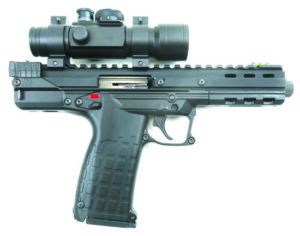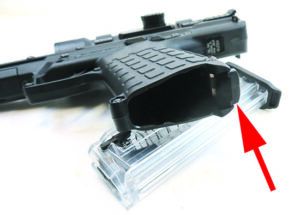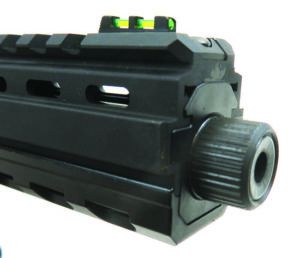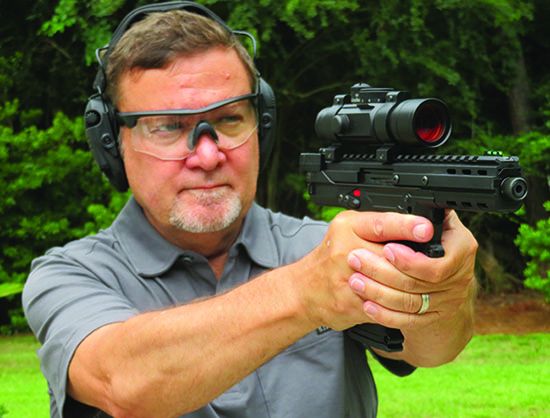Interested in shooting 22 Long Rifle pistols with red dots either at paper targets or steel plates? Ringing steel with smallbore pistols is fun. Some might say addictive. But gearing up for smallbore-pistol target shooting can be confusing because there are many choices between pistols and red-dot optics. Also, putting a ton of money into a 22 LR target pistol might not be in the budget for most shooters, but if you want to play, you’ll still want to invest enough into the pistol and optic to be competitive on the common courses of fire.
For example, one basic set up is to shoot at five to seven steel targets no smaller than 8 inches in size. Five strings are shot, and the four lowest-scored strings are your total score. Even this simple course of fire puts a premium on the gun/optic combo, with the gun needing to be accurate, reliable, and easy to move between targets, and the optic presenting a clear, simple dot that is easy to read and follow target to target.
Accordingly, we wanted to match up suitable pistols with reliable red dots. The pistol budget was set at $450 and the optic budget at $300. The goal was to have a pistol set up for about $800, not including tax and transfer fees. Happily, we came in under budget for all the pistol and optics combos. Going cheap on the red-dot optic is possible because there are many available well under $300. So we went with brands we know and have used in the past. The same was true of 22 LR target pistols. We found a Taurus TX22 Competition for $419, pairing it with a Crimson Trace RAD Micro Pro, $219, with a green dot. Total cost was $718. Middle of the pack was a KelTec CP33 ($469) and an Ultradot 6 ($289) for a total of $758. On the high end was a like-new-in-box used Ruger MK III 22/45 Threaded Barrel for $450, paired with a Shield Sight RMSx, $489, at $789.
How We Tested
Red dots allow the user to shoot with both eyes open for a wide field of view and no tunnel vision aiming. So, for the “action” style of shooting reactive targets, these optics are ideal.
What has not been ideal have been the means of putting optics on handguns, but this process is getting better. Gun manufacturers have made mounting a red dot simple by including mounting plates that are compatible with the footprint of popular optics. For instance, the Crimson Trace RAD Micro Pro has the same footprint as the Shield RMS or JPoint reflex sights. The Ultradot 6, however, mounts like a scope, using rings that clamp onto a Weaver or Picatinny rail. So, as part of our evaluation, we focused on the ease with which we could:
• Mount a red dot on the pistol
• Zero the sight
• Use the dot reticle
• Assess battery life and replacement, and
• Determine a sight’s ruggedness.
For the pistols themselves, we evaluated them on:
• Grip comfort
• Ease of and speed of loading and unloading
• Slide manipulation
• Magazine loading
• Trigger-pull weight
• Balance
• Ability to customize
• Accuracy, and
• Reliability.
Also, because they are target pistols chambered for 22 LR, we looked at field-stripping and cleaning them. Rimfire ammo with lead bullets and dry lube can quickly gunk up an action, so maintenance is important.
Ammo used consisted of two hot high-velocity loads and two mild target loads. On the hot side were CCI AR Tactical rounds with 40-grain copper-coated lead bullets and Federal AutoMatch with a 40-grain lead bullet. On the mild side were Remington Target rounds with 40-grain lead bullets and Eley Tenex with 40-grain lead bullets. All of the ammunition is specifically designed for target shooting and made for use in semi-auto pistols and rifles. Despite them all using 40-grain bullets, results varied by gun.
After we zeroed the sights, we set targets at 20 yards and employed a rest to gauge bench accuracy. For speed shooting and reload manipulations, we used paper plates as targets and set up the course at 10 yards. We then fired Bill Drills — six fast shots inside a small A zone — to see how well the pistols could be fired, controlled, and reloaded.
At the outset, we wondered if we paid too much for the used Ruger/Shield Sight combo or if the mid-priced Taurus/Crimson Trace duo would make a good set up? Was there anything good about the least expensive KelTec/Ultradot set up? Here’s what we found:
KelTec CP33 CP33BLK 22 LR
$469
Gun Tests grade: A
Accuracy was good, but the CP33 was only reliable using high-velocity ammo. The rail made mounting a sight easy, though the rail increases the distance from the bore axis. It is fun to shoot this pistol.

| Action | Semi-auto |
| Overall Length | 10.6 in. |
| Overall Height | 6.0 in. |
| Maximum Width | 2.1 in. |
| Weight Unloaded | 24.0 oz. |
| Weight Loaded | 27.9 oz. |
| Barrel | 5.5 in. long, 1:16 RH twist,½-28 tpi muzzle threads |
| Slide | Hard anodized black aluminum |
| Slide Retraction Effort | 16.0 lbs. |
| Frame | Black polymer |
| Frame Front Strap Height | 2.6 in. |
| Frame Back Strap Height | 3.5 in. |
| Grips | Textured polymer |
| Grip Thickness Maximum | 1.0 in. |
| Grip Circumference Maximum | 5.6 in. |
| Front Sight | Fixed green fiber optic |
| Rear Sight | Adjustable orange fiber optic |
| Sight Radius | 8.5 in. |
| Trigger Pull Weight | 2.6 lbs. |
| Trigger Span | 2.8 in. |
| Magazines | (2) 33 round,polymer with polymer base pad |
| Safety | Manual thumb |
| Warranty | None written |
| Telephone | (800) 515-9983 |
| Website | KeltecWeapons.com |
| Made In | U.S. |
The KelTec CP33 is an awkward-looking pistol due to the rear of the receiver, which protrudes about 2.5 inches from the rear of the pistol. That’s because the pistol is set up like a mini AR-15 rifle. There is an all-metal upper receiver that houses the barrel inside a vented handguard with a Picatinny-style rail on the top side mounted with adjustable fiber-optic sights. At the rear is a charging handle with two flared ears, so grasping and retracting the charging handle is easier. It took about 16 pounds of effort to pinch the charging handle and pull it back. The charging handle does not reciprocate when the pistol fires, which makes for less distraction when firing the pistol. The muzzle is threaded so you can add a compensator to further decrease muzzle flip.
The lower receiver is typical KelTec with two molded-polymer halves bolted together with five screws. The dust cover has an M-Lok slot allowing accessories to be attached. To the rear is the back plate with two metal loops protruding on each side. The metal loops are small, but a lanyard or light sling could be attached. The grip is very flat and shaped like a triangle, wider on the rear back strap and smaller on the front grip strap. It wears KelTec’s signature square grip texture. The magazine-release button is in the butt of the grip. The magazine does not fall free, requiring the user to pull it from the grip. While that slows down reloads, the CP33 with its uber capacity does not need to be reloaded often. The CP33’s magazine holds a whopping 33 rounds in a flush-fit body. The magazine is loaded differently than a typical 22 LR magazine. The rims of the top rounds must be in front of the rims on the cartridges underneath it. To load the magazine, press a cartridge downward in the center of the magazine, with the rim situated within the rim window, which are small notches. Then slide the cartridge back all the way before pushing another round down on top of it. Loading is fast once you understand the process. The CP33 comes with two magazines, which have clear-plastic shells so you can see if the cartridge rims are stacked properly.

The trigger is smooth and crisp, requiring only 2.8 pounds of effort to fire. It was surprisingly nice. The CP33 sports an ambidextrous thumb safety that clicks on and off using the side of your shooting-hand thumb. A red dot shows when the pistol is ready to fire. The slide stop is a medium-sized tab easily reached and manipulated by a right-handed shooter’s thumb. Lefties will have a problem because it’s not ambidextrous.
The Ultradot 6 optic is built like a scope using a tube, and like a rifle scope, two rings clamp around the tube body and attach to the Picatinny-style rail. There is a lot of rail to mount the Ultradot, and we used that to balance the pistol with the weight centered in our hand. The sight was simple to mount on the CP33. Once the optic was mounted, the pistol looked like it was a prop for the next Star Wars movie installment.
The Ultradot 6 comes with rings, bungee lens covers, hex wrench, polarizing filter, and a CR2032 battery. The sight is covered with knobs. At the top is the battery housing and dot-illumination knob, ranging from 0 to 11 brightness settings. A coin, house key, or rim of a shell is required to remove the battery cap. The brightness knob was easy to turn. Behind that knob is the elevation knob that allows a user to adjust elevation on the fly. The direction is clearly marked, and the knob can be turned with your fingers or via a flat-blade screwdriver. On the right side is the windage adjustment, which is capped and required a tool to turn it. Directions are clearly marked. On the left side is the reticle knob, allowing a user to rotate between six reticle options; four dot sizes of 2, 4, 6, and 8 minutes of angle (MOA) plus two reticles, crosshair and circle or donut. We like the variety of reticle options.

The reticle is parallex free out to 55 yards, so no matter where the user’s eye moves in relation to the scope’s axis, the reticle stays fixed on the same spot on the target. This aids with accuracy. Aiming with the Ultradot 6 was similar to using a rifle scope. The knobs on the outside of the sight blocked our view, but if you are focused on the reticle, that was not an issue. The weight of the sight is 6 ounces, bringing the total weight of unloaded gun and optic to 30 ounces. That extra weight helped stifle muzzle flip, not that there is a lot with 22 LR ammo. The optic kept the pistol flat, so getting back on target was quick. We ripped through the paper plate targets.
To load the CP33, pull back the charging handle similar to an AR-15. It was apparent from the first shot that this pistol could perform. The trigger was crisp and light so we could concentrate on putting the reticle on the target more and less on trigger press. Reset, however, is about 1⁄4 inch.
At the range, the CP33 provided excellent accuracy. With the Eley Tenex, the best five-shot group measured 0.52 inch. Unfortunately, the Eley ammo had a few failures-to-feed (FTF) issues in the KelTec. The light Remington Target load also gave us a few FTF jams, and we had one dud with the Remington ammo. But the hotter CCI and Federal ammo ran excellently. Now we know why the manual suggests high-velocity ammo only.
On average across all ammo choices, group sizes averaged 0.68 to 0.76 inch. We attribute the small groups to the light trigger and clean red dot. During accuracy testing we scrolled through the reticle options and adjusted brightness. The larger donut or circle with crosshair sights completely covered the bullseye, while the 2-MOA dot offered a clean aiming point for precision work. Because the optic uses rings and is farther above the bore axis, you need to lower the pistol to acquire the dot when aiming. This is something you adapt to after training and practice.
On the plates, the KelTec was easy to shoot fast and accurately due to the weight and crisp trigger. The recoil gently rocks the pistol in your hand. The CP33 had plenty of surface area to grasp with the support hand. The charging handle does not reciprocate, and the bolt locks back on the last round fired.
The magazine is easy to load once you get the rhythm of it, and the clear plastic lets you see if the rims are stacked properly.
Field-stripping the CP33 is fairly straightforward. The upper and lower receivers separate when one pin is removed, giving access to the charging handle and bolt assembly. If you can field-strip an AR-15, the CP33 is similar. Because the barrel is fixed to the upper, there is no need to worry about losing zero on the optic.
Our Team Said: The gawky-looking CP33 has a nice trigger and offers plenty of accuracy and capacity. As an intro gun to smallbore target shooting, this would be a good choice. The Ultradot 6 optic is a bit old-school compared to modern reflex sights, but it offers a variety of reticles and allows you to adjust brightness setting for dim or bright light. It also adds weight to the pistol to help control muzzle flip. This is a very good set up for the money.
| 22 LR RANGE DATA | |||
| CCI AR Tactical 40-grain Copper Coated Lead | KelTec CP33 | Ruger MK III 22/45 | Taurus TX22 Competition |
| Average Velocity | 1066 fps | 994 fps | 1040 fps |
| Muzzle Energy | 101 ft.-lbs. | 88 ft.-lbs. | 96 ft.-lbs. |
| Smallest Group | 0.68 in. | 1.37 in. | 0.97 in. |
| Average Group | 0.76 in. | 1.44 in. | 1.09 in. |
| Federal AutoMatch 40-grain Lead | KelTec CP33 | Ruger MK III 22/45 | Taurus TX22 Competition |
| Average Velocity | 1009 fps | 988 fps | 1009 fps |
| Muzzle Energy | 90 ft.-lbs. | 87 ft.-lbs. | 90 ft.-lbs. |
| Smallest Group | 0.65 in. | 0.70 in. | 0.82 in. |
| Average Group | 0.68 in. | 0.76 in. | 0.83 in. |
| Remington Target 40-grain Lead | KelTec CP33 | Ruger MK III 22/45 | Taurus TX22 Competition |
| Average Velocity | 932 fps | 957 fps | 980 fps |
| Muzzle Energy | 77 ft.-lbs. | 81 ft.-lbs. | 85 ft.-lbs. |
| Smallest Group | 0.61 in. | 0.62 in. | 1.39 in. |
| Average Group | 0.70 in. | 0.76 in. | 1.46 in. |
| Eley Tenex 40-grain Lead | KelTec CP33 | Ruger MK III 22/45 | Taurus TX22 Competition |
| Average Velocity | 934 fps | 877 fps | 915 fps |
| Muzzle Energy | 77 ft.-lbs. | 68 ft.-lbs. | 74 ft.-lbs. |
| Smallest Group | 0.52 in. | 1.31 in. | 1.02 in. |
| Average Group | 0.71 in. | 1.55 in. | 1.33 in. |
Written and photographed by Robert Sadowski, using evaluations from Gun Tests Team members. GT



























